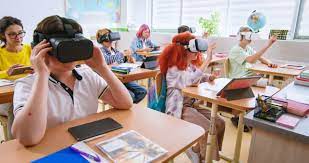I. Introduction
The integration of technology in the classroom has transformed traditional teaching methods, creating a dynamic and interactive learning environment. This article explores the impact of technology on education, examining the ways it enhances learning experiences, empowers educators, and prepares students for the digital age.
II. Interactive Learning Tools
a. Smartboards and Interactive Displays
- Dynamic Presentations: Smartboards allow educators to create dynamic presentations, enhancing engagement and interaction.
- Collaborative Learning: Interactive displays facilitate collaborative learning, encouraging student participation.
b. Educational Apps and Software
- Customized Learning: Apps and software provide personalized learning experiences, catering to individual student needs.
- Gamified Learning: Educational games make learning enjoyable, turning lessons into interactive and gamified experiences.
III. Digital Resources and Online Libraries
a. Access to Rich Content
- Vast Information: Digital resources provide access to a vast pool of information, enriching lesson content.
- Multimedia Learning: Online libraries offer multimedia resources, making learning more engaging and comprehensive.
b. E-books and Digital Textbooks
- Portability and Accessibility: E-books and digital textbooks are easily accessible, promoting anytime, anywhere learning.
- Interactive Features: Digital textbooks often include interactive elements, quizzes, and multimedia content to enhance understanding.
IV. Virtual Reality (VR) and Augmented Reality (AR)
a. Immersive Learning Experiences
- Virtual Field Trips: VR allows students to embark on virtual field trips, providing immersive experiences beyond the classroom.
- AR for Visualization: Augmented reality aids in visualizing complex concepts, making abstract subjects more tangible.
b. Simulations and Experiments
- Science and Lab Simulations: Virtual simulations enable students to conduct experiments in a virtual environment, fostering practical understanding.
- Historical Re-creations: AR can re-create historical events, bringing history to life for a more engaging learning experience.
V. Distance Learning and Collaboration Tools
a. Online Classrooms and Video Conferencing
- Global Accessibility: Distance learning allows students to access education globally, breaking geographical barriers.
- Real-Time Collaboration: Video conferencing tools facilitate real-time collaboration among students and educators.
b. Cloud-Based Platforms
- Efficient Resource Management: Cloud-based platforms streamline resource sharing, assignment submissions, and collaborative projects.
- Accessibility Across Devices: Students can access learning materials and assignments from various devices, promoting flexibility.
VI. Teacher Empowerment and Professional Development
a. Data Analytics and Student Progress Tracking
- Individualized Feedback: Technology enables teachers to provide individualized feedback based on data analytics, addressing specific student needs.
- Progress Monitoring: Teachers can track student progress over time, identifying areas that may require additional focus.
b. Professional Development Opportunities
- Online Workshops and Courses: Educators can engage in online workshops and courses to enhance their teaching skills and stay updated on educational trends.
- Resource Sharing Communities: Online communities facilitate resource sharing and collaboration among educators, fostering a culture of continuous learning.
VII. Addressing Challenges and Concerns
a. Digital Literacy Education
- Incorporating Digital Literacy: Schools must prioritize digital literacy education to ensure students can navigate and critically evaluate online information.
- Cybersecurity Measures: Implementing robust cybersecurity measures to protect student data and ensure a safe online learning environment.
b. Equitable Access to Technology
- Closing the Digital Divide: Schools must work towards providing equitable access to technology, addressing socioeconomic disparities.
- Community Partnerships: Collaborating with community organizations and businesses can help bridge the gap in access to technology.
VIII. Conclusion
The integration of technology in the classroom is a transformative force that goes beyond simply enhancing learning experiences. It prepares students for a digital future, equips educators with powerful tools, and fosters a collaborative and dynamic educational ecosystem. While challenges exist, addressing them through thoughtful implementation and ongoing professional development can ensure that technology continues to play a positive role in shaping the future of education.
FAQs
- Q: How do interactive displays enhance learning in the classroom?
- A: Interactive displays, such as smartboards, create dynamic presentations, encourage collaborative learning, and increase student engagement.
- Q: What are the benefits of virtual reality (VR) and augmented reality (AR) in education?
- A: VR provides immersive experiences like virtual field trips, while AR aids in visualizing complex concepts and re-creating historical events for a more engaging learning experience.
- Q: How does technology empower teachers and support professional development?
- A: Technology allows teachers to track student progress, provide individualized feedback, and engage in professional development through online workshops and courses.
- Q: What challenges does the integration of technology in education face?
- A: Challenges include the need for digital literacy education, ensuring equitable access to technology, and addressing concerns related to cybersecurity and student data privacy.
- Q: How can schools address the digital divide and ensure equitable access to technology?
- A: Schools can work towards closing the digital divide by implementing initiatives, partnering with community organizations, and providing resources to ensure equitable access to technology.

